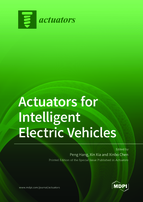Actuators for Intelligent Electric Vehicles
A special issue of Actuators (ISSN 2076-0825). This special issue belongs to the section "Actuators for Land Transport".
Deadline for manuscript submissions: closed (15 January 2022) | Viewed by 64731
Special Issue Editors
Interests: decision-making; autonomous driving; game theory; path tracking and control
Special Issues, Collections and Topics in MDPI journals
Special Issue Information
Dear Colleagues,
The electrification and intelligence of automobiles have become popular in recent years. The intelligent electric vehicle (IEV) is a transformative technology that is expected to change and advance the safety, comfort, efficiency, handling stability, and maneuverability of automobiles. As the main functional components of IEVs, advanced actuators and control algorithms of steering, driving, and braking systems are of great importance. With these advanced actuators, different control frameworks and strategies are yielded for IEVs, including an antilock brake system (ABS), autonomous emergency braking (AEB), electronic stability control (ESC), differential braking, active front steering (AFS), active rear steering (ARS), and active suspension system (ASS). Thanks to these advanced control frameworks and strategies, the performances of IEVs can be remarkably improved.
This Special Issue aims to attract papers devoted to any aspect of advanced actuators for IEVs and the design of control algorithms. The topics of interest within the scope of this Special Issue include, but are not limited to, the following:
X-by-wire actuator for IEVs;
Advanced actuators for steering, braking, and driving;
Control of active suspension system;
Advanced control algorithms for IEVs;
Collaborative control of human driver and IEV;
Advanced Driving Assistance System (ADAS);
Decision making, motion planning, and control of IEVs;
Dr. Peng Hang
Dr. Xin Xia
Prof. Dr. Xinbo Chen
Guest Editors
Manuscript Submission Information
Manuscripts should be submitted online at www.mdpi.com by registering and logging in to this website. Once you are registered, click here to go to the submission form. Manuscripts can be submitted until the deadline. All submissions that pass pre-check are peer-reviewed. Accepted papers will be published continuously in the journal (as soon as accepted) and will be listed together on the special issue website. Research articles, review articles as well as short communications are invited. For planned papers, a title and short abstract (about 100 words) can be sent to the Editorial Office for announcement on this website.
Submitted manuscripts should not have been published previously, nor be under consideration for publication elsewhere (except conference proceedings papers). All manuscripts are thoroughly refereed through a single-blind peer-review process. A guide for authors and other relevant information for submission of manuscripts is available on the Instructions for Authors page. Actuators is an international peer-reviewed open access monthly journal published by MDPI.
Please visit the Instructions for Authors page before submitting a manuscript. The Article Processing Charge (APC) for publication in this open access journal is 2400 CHF (Swiss Francs). Submitted papers should be well formatted and use good English. Authors may use MDPI's English editing service prior to publication or during author revisions.







